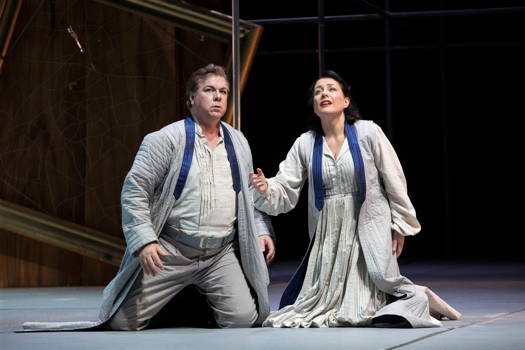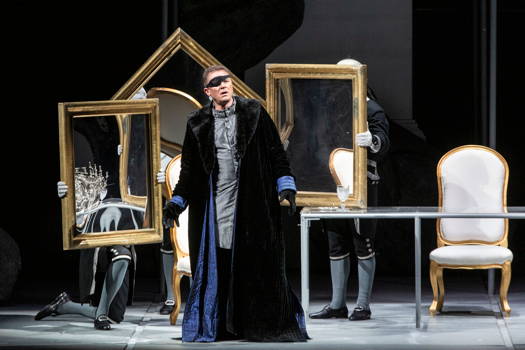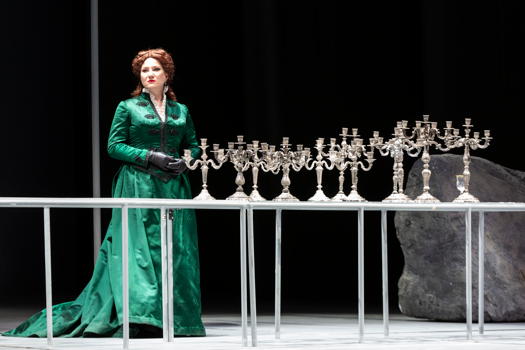 SPONSORED: Ensemble. A Great Start - Freddie Meyers' new opera A Sketch of Slow Time impresses Alice McVeigh.
SPONSORED: Ensemble. A Great Start - Freddie Meyers' new opera A Sketch of Slow Time impresses Alice McVeigh.
All sponsored features >>
Tradition and Passion
GIUSEPPE PENNISI reviews a revival of
Wagner's 'Die Walküre' in Naples
On 16 May 2019, I was at the San Carlo Opera House in Naples, not for a premiere of a new production but for a much awaited revival of a very successful staging of Richard Wagner's Die Walküre which I had seen, heard, and reviewed in an Italian daily paper in March 2005. The conductor and the cast were, of course, different. However, the stage direction (Federico Tiezzi), the sets (Giulio Paolini) and the costumes (Giovanna Buzzi) were the same. Indeed, I think that the creative team had rehearsed the revival. In 2006, the National Association of Music Critics awarded the staging of this Die Walküre the 'Premio Abbiati', the most important prize in Italy for music theatre and concerts. Then, the stage production seemed almost daring: abstract sets, timeless costumes, very careful acting. There were some controversies but the creative team convinced the music reviewers. Now, an abstract setting and timeless costumes are nearly part of the operatic tradition and syntax. There was also a lot of passion in the acting. After so many years, the mix worked even better than in 2005.
On 16 May, many young people and students were in the audience, as part of a policy to encourage youngsters to attend classical music. In the morning, their younger brothers and sisters were attending a children's performance of Il Barbiere di Siviglia tailored to elementary school pupils.
Die Walküre is the most frequently performed of the four operas of Wagner's Ring Cycle. It is compact: three Acts, each one of about eighty minutes; musically each Act is divided in three sections. Thus, it is a rather symmetric opera, still anchored to the German Romantic style - ie preceding Wagner's musikdrama. A determinant for the popular success of Die Walküre is that it deals mostly with love intertwined with power politics. Love and power are two staples of music theatre. Each spectator can easily give his own personal meaning to the music in the pit and to the action on stage. It is a complex love story because several facets of love overlap each other. Hunding has sadistic sexual passion for Sieglinde. Siegmund and Sieglinde are in total passionate love - honest and pure in spite of the adulterous and incestuous intercourse.

Robert Dean Smith as Siegmund and Manuela Uhl as Sieglinde in Die Walküre at Teatro di San Carlo in Naples. Photo © 2019 Luciano Romano
There is a tired marriage relationship between Wotan and Fricka, and the motherly love of Sieglinde for her yet-to-be-born child, Siegfried. Most significantly there is Brünnhilde's complex love for her father, Wotan, her half-brother and her half-sister - Siegmund and Sieglinde, and her other sisters - the Valkyries. Power politics is central to the plot because the King of the Gods, Wotan, wants to betray his own basic laws but he is stopped from doing so by his long term (and often misled) wife Fricka. Thus, Brünnhilde becomes his willing executioner (in breaking the laws); in spite of her own father's inner wish, she is to be punished.

Iréne Theorin as Brünnhilde in Die Walküre at Teatro di San Carlo in Naples. Photo © 2019 Luciano Romano
Die Walküre is one of Wagner's most popular works, as well as the most performed opera of the Ring Cycle, also because it is full of action on stage - races, duels, fights and rides - not through the accounts of the protagonists (as, for example, in Siegfried). A single exception is Wotan's fifteen minute monologue in Act II.

Egils Silins as Wotan in Die Walküre at Teatro di San Carlo in Naples. Photo © 2019 Luciano Romano
In this review, the photographs show the salient visual aspects of the production quite well. They are more eloquent than written comments. Thus, I focus on the musical aspects.

A scene from Die Walküre at Teatro di San Carlo in Naples. Photo © 2019 Luciano Romano
In 2005, the conductor was the late Jeffrey Tate. He rendered a manicured Die Walküre similar to that recorded by Georg Solti who considered the first Act of the opera a true Kammerspiel. Now in the pit is Juraj Valčuha, who not only conducts the orchestra, but also gives cues to the singers, softens the sound when he fears that they are having difficulties, molds the sonorities in line with their acting, slows the tempos in the most lyric parts of the opera and sharpens them when the action is moving. Especially, he extracts all the passion from the score. The San Carlo orchestra plays very well following his instruction. In the overall production, Valčuha is a real protagonist as an energetic and passionate music director.

A scene from Die Walküre at Teatro di San Carlo in Naples. Photo © 2019 Luciano Romano
The audience feels the atmosphere from the introduction to the first Act - Siegmund's run to a shelter - Sieglinde and Hunding's cabin in the forest. Valčuha discloses the peculiarity of the first Act: in spite of Wagner's theoretical writings, there is a great deal of music that the composer never, or rarely, makes use of subsequently in the Ring Cycle; thus there are almost no leitmotiven until Siegmund's tonic B flat motif signaling that a new love is born.
The staging opts for a highly stylized approach: there are no dogs, and none of Hunding's henchmen running after Siegmund. The cabin is like an abstract stylized painting where the outline of high trees dominates the scene. The lighting is dark at the beginning but the stage brightens when at the end of the Act, a sunny dawn breaks in. Manuela Hul (Sieglinde) emphasizes her high notes somewhat excessively. Robert Dean Smith is a good Siegmund, especially in going from heroic tenor accents to almost those of a lyric tenor style; he has an excellent legato. Liang Ling is a cavernous Hunding with a very powerful volume.
In the second Act, we are in the 'middle of things', starting with the masterpiece of leitmotiv manipulation: we hear the Sword and Hunting motive finally flowing into the Valkyries' ride. Three excellent singers (and magnificent actors) take the center stage: Egils Silins, a Latvian bass-baritone with a very extended range, as Wotan, a superb Iréne Theorin as Brünnhilde and a very good Ekaterina Gubanova as Fricka.

Ekaterina Gubanova as Fricka in Die Walküre at Teatro di San Carlo in Naples. Photo © 2019 Luciano Romano
Readers may recall that Ms Theorin was Brünnhilde in a recent Ring Cycle in Palermo and Ms Gubanova in a cycle at La Scala. Valčuha takes a very solemn approach to Wotan's monologue and to the three confrontations - Wotan versus Brünnhilde, Wotan versus Fricka, and again Wotan versus Brünnhilde. He, the orchestra and the singers deliver an engrossing Todesverkündigung, when Brünnhilde announces to Seigmund that he must die, but she is won over by the human plight of the young man and his sister-bride. The somber mood drops like a weight from the music and the lovers' encounter ends in great jubilation, before the double killing drama ending the Act.

A scene from Die Walküre at Teatro di San Carlo in Naples. Photo © 2019 Luciano Romano
In the third Act, the protagonists and the eight Valkyries are quite effective musically and vocally. In the first part, there is emphasis on polyphony that slides into Sieglinde's exalted rapture. Then we hear a motif which makes only a few appearances in the Ring Cycle but carries the highest significance when it does appear. It is also the last motif in the final scene of Götterdämmerung: according to some authors, it means transformation, and to others: redemption through love. Ms Hul and Ms Theorin had the perfect emission and volume; the orchestra stressed the appassionato, an anticipation of the blessing at the end of the cycle.

The Valkyries: Raffaela Lintl as Gerhilde, Pia-Marie Nilsson as Ortlinde, Ursula Hesse Von Den Steinen as Waltraute, Julia Gertseva as Schwertleite, Robyn Allegra Parton as Helmwige, Ivonne Fuchs as Siegrune, Niina Keitel as Grimgerde, and Alexandra Ionis as Rossweisse in Die Walküre at Teatro di San Carlo in Naples. Photo © 2019 Luciano Romano
The last scene - Wotan's farewell to Brünnhilde - is the opera's moving climax. The Theorin-Silins duet was enrapturing; the orchestral peroration, when Wotan agrees to surround his sleeping daughter with a wall of fire, was moving. The tremendous E major chord was highly emotional: the now helpless King of the Gods embraces Brünnhilde before the music dissolves the intense father-daughter relationship into a magic fire. The fire music is initially brisk and then increasingly lower in diminuendo.
The audience entered the San Carlo Theatre before 6pm and the performance ended at 11.20pm, with two intermissions of twenty minutes each. There were ten minutes of accolades.
Copyright © 19 May 2019
Giuseppe Pennisi,
Rome, Italy




